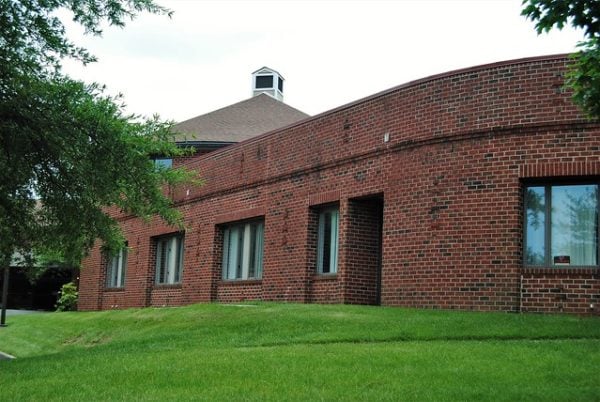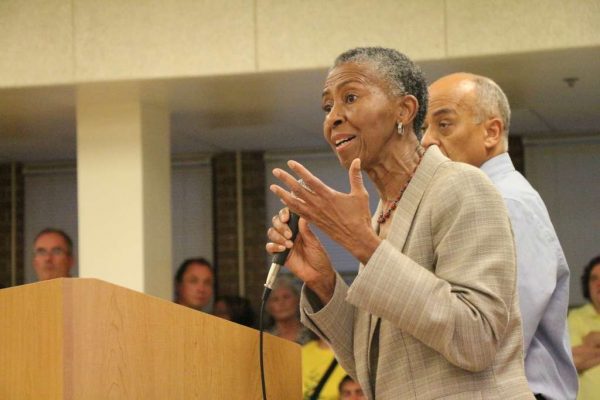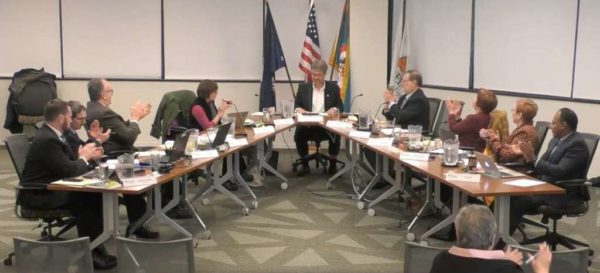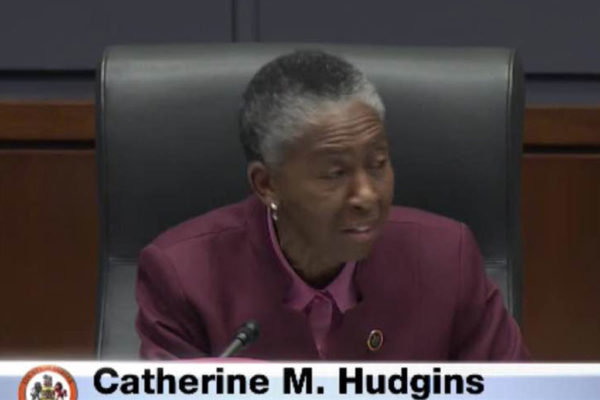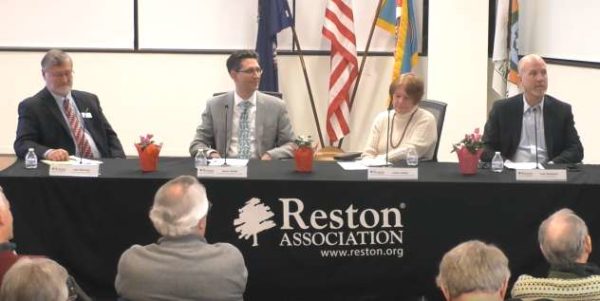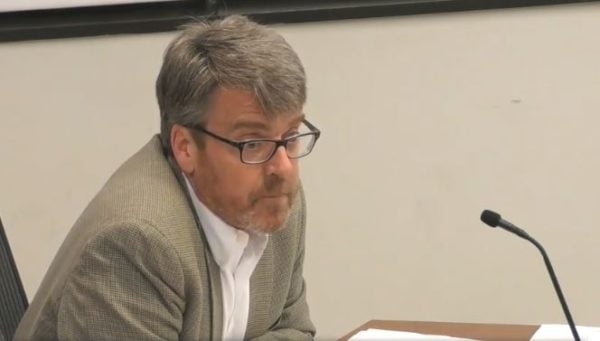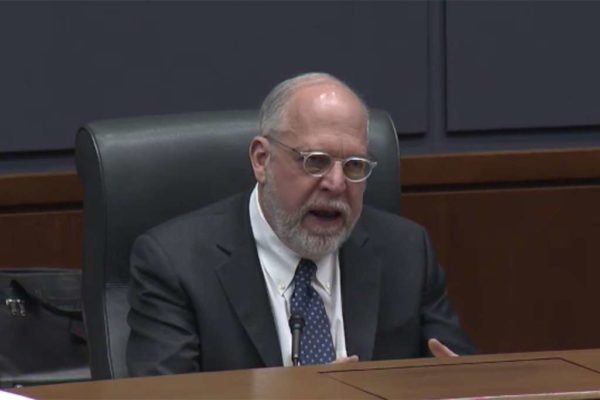
A task force chaired by Hunter Mill District Supervisor Walter Alcorn kicked off a review of Reston’s guiding planning and development document Monday night.
The 24-member group, which includes representatives from community organizations, developers, and real estate professionals, reviewed the primary objectives of the task force, which Alcorn assembled earlier this year. Over the next several months, members will develop recommendations on Reston’s Comprehensive Plan, which has been criticized by residents and others for not being up to date with the current and future pace of development.
Since the plan was last updated in 2014, 39 major zoning applications have been approved and 12 major zoning applications are in process, according to Chris Caperton, deputy director of the county’s planning and development department. More than 14 million square feet of commercial development and 13.4 million square feet of residential development have been approved, according to 2019 data.
Alcorn outlined a review of the following focus areas:
- Projected population thresholds
- Land use in Reston’s village centers
- An evaluation of the plan’s language regarding more affordable housing and the preservation and improvement of existing affordable housing
- Planned pedestrian and bicycle infrastructure to access Metro stations
- If the plan provides adequate guidance on urban scale mobility and development design in Reston’s Transit Station Areas while protecting neighborhood stability of nearby areas
- Transportation improvements and their alignment with planned development
- How the plan can better enhance Reston’s natural environment and encourage energy efficiency
- How the plan address concerns about the “monopolization” of ownership in Reston, especially pertaining to Boston Properties’ ownership of Reston Town Center
- If the historic practice of promoting privately-owned open space addresses public needs for the next 50 years
Alcorn said the task force’s timetable was “aggressive” to complete its work. The next meeting, which will be held online, is slated for May 26.
He also clarified that discussions around the future ownership of Reston Town Center would center around whether or not there is a longterm vision of the ownership of Reston’s commercial center.
The review will not be restricted to Reston’s Planned Residential Community District. A county proposal to increase that district’s population density — among other proposed changes — drew community rancor and was ultimately deferred last year.
Others encouraged the task force to take a close look at whether or not the plan provides sufficient guidance on managing the pace of infrastructure and development in the area.
Reston Association board member John Mooney said he was concerned that county studies have primarily examined the effect of development in Reston’s Transit Station Area (TSA) on traffic specific in that area.
After a series of meetings, the task force will pitch recommendations to the Fairfax County Planning Commission. The Fairfax County Board of Supervisors will then vote on any proposed amendments to the plan.
More information about the task force and upcoming meetings is available online.

Walter Alcorn, the incoming Hunter Mill District Supervisor who won a five-way Democratic primary, plans to prioritize managing growth and infrastructure as he takes over for retiring Cathy Hudgins on Jan. 1.
As cranes scrape the skies and community consternation about development continues to rumble, one of Alcorn’s top priorities is to update and improve Reston’s major planning document — phase two of Reston’s comprehensive plan.
“Our biggest challenge is clearly managing the growth that we’re undergoing right now, both in terms of mobility and change and our quality of life,” Alcorn said in a recent interview with Reston Now.
He hopes to incorporate measures that manage growth and infrastructure — including population projections that can guide infrastructure needs, planning for public facilities like transportation and schools, and expectations for public open space. Alcorn also hopes to incorporate language to preserve existing affordable housing and clarify expectations surround the future redevelopment of Reston’s village centers, some of which are in need of revitalization.
Although Alcorn has not pitched specific recommendations — a public feedback process in early 2020 will guide the community conversation — the Democrat has one specific idea: breaking up the ownership of Reston Town Center.
Alcorn says the county can incorporate language in the comprehensive plan to “call for diverse ownership of Reston Town Center” in order to break up the “monopolistic” ownership of Reston’s core from Boston Properties. The move would address concerns related to vacancies and the departure of small businesses following the company’s seismic shift to paid parking in 2017.
For now, the controversial discussion on increasing Reston’s population density per acre in the Planned Residential Community district — the community’s primary zoning district has been indefinitely delayed.
Alcorn believes the county should reexamine Reston’s comprehensive plan before reconvening discussions on the tabled PRC proposal.
“We need to fix the comprehensive plan,” Alcorn told Reston Now. “My first priority is to fix the comprehensive plan.”
He also wants to explore ways to streamline how Reston-related development proposals are reviewed, particularly between the Hunter Mill District Land Use Committee, which advises the supervisor’s office on land use issues, and the Reston Planning & Zoning Committee. Possible proposals include improving the public input process, adding county staff support to attend meetings and improving the sequencing of the multi-step approval process.
“Many times, these groups are asked to make recommendations on zoning before they can even see proffers associate with rezoning,” he said.
Other county-wide initiatives Alcorn hopes to take a lead on include:
- A land use reform initiative to create affordable housing opportunities, in conjunction with other supervisors
- Efforts to improve pedestrian mobility through regional initiates and more comprehensive planning beyond the county’s bicycle master plan.
As he begins his term on Jan. 1, Alcorn hopes to leverage his experience as a former planner with the county to ensure the vitality and promise of Reston remains.
“I come to this job with good knowledge of the land use process and also a commitment to engage the public and the community in that land use process,” he says. “We’re at an interesting time in Reston with transit-oriented development underway and older communities that are in need of retention. That is something that is new.”
Photo via Facebook
Candidates for Hunter Mill District Supervisor Discuss Reston’s Future — Candidates running for the seat submitted answers to the Coalition for a Planned Reston’s questionnaire on the community’s future. Topics include whether or not the Fairfax County Planning Commission should increase the density of Reston’s Planned Residential Community and the elimination of waivers granting exceptions to open space requirements. [Coalition for a Planned Reston]
“Nutrition for a Wealth of Health” Event Tonight — An in-store nutritionist from Giant Foods discusses eight steps to a wealth of health at Reston Regional Library from 7-8 p.m. [Reston Regional Library]
Virginia’s “LOVE” Letters Say Goodbye to Reston Town Center — The iconic letters move from RTC, their home for two days, to the Fairfax County Government Center. Next, they’ll head to Wolf Trap from July 12-24 and Frying Pan Farm Park from July 26 through August 4. [Reston Patch]
Photo via vantagehill/Flickr
It’s been a quiet two months since the Fairfax County Board of Supervisors voted to indefinitely defer the consideration of the hotly debated Planned Residential Community district proposal in early March.
Hunter Mill District Supervisor Cathy Hudgins and the county’s planning staff plan to discuss future steps in an internal meeting by early May, according to a legislative assistant for the Hunter Mill District. The office deferred questions on the proposal and next steps until discussions have taken place and new leadership for the Planning and Zoning Department are updated about the process thus far.
The proposal, which would have increased the maximum allowed population acre in PRC from 13 to up to 15 people, was put on hold on March 5 at the request of Hudgins. She said she wanted to work with the community to address concerns about the redevelopment of village centers, managing growth with infrastructure improvements, and misinformation in the community.
County officials will likely examine the future of Reston’s village centers before reconsidering the PRC proposal — a plan suggested by the Fairfax County Planning Commission. Hudgins also concurred with the suggestion.
No other information about the future of the proposal was released as the county takes “a short breather,” the legislative assistant told Reston Now.
File photo
 Reston Association’s Board of Directors elected Catherine Baum to the position of board president Wednesday night.
Reston Association’s Board of Directors elected Catherine Baum to the position of board president Wednesday night.
In her candidate statement, Baum, a former real estate executive who currently advocates for people with dementia residing in memory care, addressed a controversial debate around the Planned Residential Community — Reston’s primary zoning district.
“Let me state clearly for anyone concerned: I am not now and nor will I ever be for unfettered development throughout the PRC,” Baum said. “I supported and will continue to support every motion made and seconded relative to RA dealings with Fairfax County on this topic.”
While the Fairfax County Board of Supervisors voted in March to “indefinitely defer” the consideration of a proposed zoning amendment regarding the PRC, the hotly debated issue will likely resurface in the future.
Baum also outlined her priorities as the board’s president.
“Our most important job this coming summer and fall is to pass a 2021 biennial budget,” Baum said, adding that the board must support the new Chief Executive Officer Hank Lynch and use data.
“We will have to make tough and sometimes unpopular decisions made on facts,” she said.
Baum was the only candidate nominated to be president. After South Lakes District Director Julie Bitzer nominated Baum, At-Large Director Ven Iyer urged the future president to improve the board’s inclusivity.
“I would like to say I am disappointed in the way my colleagues have conducted discussion in the past year, and it’s because whenever there has been a dissenting or an opposing view, it has often been ridiculed. It has often been cut short,” Iyer said.
Iyer said that he has seen board members aim to form a majority to win motions.
“My request to the future president is to try to be inclusive and to make sure that all board members seem to be heard,” Iyer said. “These board discussions are not about proving your point. They’re about making progress.”
In response to Iyer’s concerns, Baum said that “each of you holds yourself accountable to everyone else on this board.”
The other officers chosen are:
- Vice President Julie Bitzer
- Secretary John Mooney
- Treasurer Eric Carr
Photo courtesy Reston Association
At his last meeting as the president of the Reston Association’s Board of Directors, Andy Sigle shared the changes he has seen in the past year and his proudest accomplishments as the association’s leader.
Sigle first joined the board in 2011 and was elected as the president last year.
“When I began the term this past spring, things were in a little bit of a tumult,” Sigle said at last night’s meeting (March 21). “We were without a permanent CEO. The CFO had recently resigned. The board was in a big transition.”
Bringing stability and positivity to the association were his personal goals as the board’s president, he said. “I think we have done that and thank you.”
Sigle shared his top three accomplishments:
- co-leading the charge against a proposed density increase for the Planned Residential Community (PRC)
- passing the RA’s budget
- hiring the new Chief Executive Officer Hank Lynch
The new board is set to select its new president after the elections for five uncontested seats end in early April.
The Fairfax County Board of Supervisors unanimously approved Hunter Mill District Supervisor Cathy Hudgins’ motion to “indefinitely defer” the consideration of a proposed zoning amendment.
The zoning ordinance has been a hotly debated issue among Restonians.
It would have increased the maximum allowed population per acre in the Planned Residential Community (PRC) district — Reston’s primary zoning district — from 13 persons to any number up to 15, along with allowing residential development at a density of up to 70 dwelling units per acre in certain areas.
“There are those in the community who do not support this change to the PRC density because they do not support redevelopment of the village centers and are concerned about future growth in Reston,” Hudgins told the board before the vote. “There is also concern that this PRC amendment will somehow support residential development on one or both of the two golf courses in Reston.”
Hudgins also said that misinformation has plagued the push to update the zoning ordinance and thanked the staff for their work educating the community.
“I had hoped that we could have found a way to provide the necessary zoning tool to implement the adopted Reston Plan,” Hudgins said.
Hudgins said that she will work with staff and community representatives to outline a process and timeframe to reexamine the plan for the village centers before reconsidering the PRC amendment — the Planning Commission’s suggested solution.
The vote came shortly after noon on Tuesday (March 5) during the board’s meeting.
Chairman Sharon Bulova told Hudgins that she understands the PRC amendment has been difficult for her and the Reston community.
“This is not easy, and I know that folks have asked for the opportunity to maybe step back and try to revisit the process that will allow things to move forward in a way that has more community engagement and more community support for a path forward,” she said.
Photo via Fairfax County
Updated at 4:45 p.m. — Hunter Mill District Supervisor Cathy Hudgins is expected to “indefinitely defer” the decision tomorrow, according to emails obtained by Reston Now. A reason was not given.
Updated at 4:30 p.m. — A public hearing on a Reston PRC zoning ordinance that was slated for tomorrow will not be held, a Fairfax County staffer told Reston Now.
Earlier: The agenda for the Fairfax County Board of Supervisors’ meeting tomorrow (March 5) just got lighter now that it doesn’t plan to hold a public hearing on a hotly debated issue among Restonians.
The public hearing, which was scheduled to take place after 4:30 p.m. and be the last item on the agenda, will not be happening, a Fairfax County staffer told Reston Now. The staffer was not aware of the reason.
Back in February, Fairfax County’s Planning Commission recommended that the Board of Supervisors deny the specific proposal, which would have increased the maximum allowed population per acre in the Planned Residential Community (PRC) district — Reston’s primary zoning district — in certain areas.
The board is set to authorize advertisements of a public hearing for an ordinance that would establish Economic Revitalization and Redevelopment Zones (ERRZs) throughout the county.
The zones stem from a bill passed by the General Assembly in 2017 that “provides for regulatory flexibility and financial incentives to encourage the private sector to assemble property for economic development purposes,” according to county documents.
The proposed amendment would offer expedited processing of development applications and other regulatory and economic incentives to private sector developers.
The commercial revitalization area of the Lake Anne Village Center would be one of the zones established, along with others including McLean and Springfield, Baileys Crossroads and more.
Photo via Fairfax County Government/Facebook
Voting for Reston Association’s elections begins today for five uncontested seats on the Board of Directors.
Three candidates are incumbents:
- Catherine Baum for a one-year term as the Apartment Owners Representative
- Caren Anton for a one-year term as the Hunters Woods/Dogwood Representative
- John Mooney for a three-year term as the North Point Representative
Tom Mulkerin, a residential real estate agent who has served on the board of the Lakewinds II Cluster Association, is running for a three-year-term At-Large seat.
Aaron Webb, who has served on the board of the Lakeside Cluster, is running for a three-year term for the Lake Anne/Tall Oaks Representative, which is currently filled by Sherri Herbert.
Mooney, Mulkerin, Webb and Anton participated in a candidates’ forum last week where they responded to questions about resource management, Reston’s density cap, the board’s authority and community outreach.
At least 10 percent of eligible voters are needed to make the results official.
The month-long voting period ends on April 1. The results will get announced at the Annual Members’ Meeting in April.
Photos courtesy Reston Association
Four of the five candidates for the five open seats on the Reston Association’s Board of Directors responded to 15 questions at a candidates’ forum Wednesday night (Feb. 27).
The questions came from a handful asked by the Elections Committee and 10 from audience members. The candidates are:
- Caren Anton running for re-election to a one-year term as the Hunters Woods/Dogwood Representative
- John Mooney running for re-election to a three-year term as the North Point Representative
- Tom Mulkerin running for a three-year-term At-Large seat
- Aaron Webb running for a three-year term for the Lake Anne/Tall Oaks Representative, which Sherri Herbert plans to vacate
Four main themes kept popping up — Reston’s density cap, resource management and programming, the board’s structure and responsibilities and community outreach. Here’s what the candidates had to say about each of those topics.
Resource management and programming
Anton emphasized that it is important to get information from RA members about which resources they use and don’t use and what they would like to see offered.
“Our facilities have been here for a long time, and we do a reserve study but I think it’s important to get input from our members and integrate into the budgeting process,” she said.
Webb echoed Anton, saying that data should drive resource management decisions. “I think there’s a large percentage of Reston that is happy with what we’ve got,” Webb said.
Mooney and Mulkerin said that a reserve study will help guide the RA’s asset management.
As for cutting back on nonessential programming, Webb and Mooney stressed that the financial viability of the association should shape the scope of programming, while Mulkerin and Anton stressed that programs not generating revenue shouldn’t be eliminated right away without trying to find alternative funding solutions
Mooney stressed that the RA should be ready “to divest ourselves of things that do not have value, but do a careful longterm look at it.”
RA’s structure and responsibilities
Recently, the board started rethinking the power structure of RA’s key staff. A resolution before the board addresses specifically RA’s legal counsel, chief financial officer, director of finance, controller, chief operating officer and the authority of the board’s chief executive officer. Currently, RA’s bylaws say that the chief executive officer controls personnel and compensation schedules, along with hiring and firing responsibilities.
Webb and Mulkerin said they did not have knowledge about the current relationship between the CEO, CFO and board to comment.
Mooney said that because the CEO comes up with and implements the annual budget, the CFO is his “chief ally,” adding that defining the authority will help make sure that the board does not reach beyond its legal limits. Mooney said that the CEO should have daily direction of the CFO, while the CFO should have “ready recourse to the board and vice versa.”
“I do feel it is the CEO who does the hiring the firing of the CEO,” Anton said
An audience question about how the RA relates to the small tax district stumped the candidates.
PRC zoning ordinance amendment
A controversial zoning ordinance proposal for Reston recently has been the subject of many debates recently for Restonians.
The zoning ordinance would increase the maximum allowed population per acre in the Planned Residential Community (PRC) district — Reston’s primary zoning district — from 13 persons to any number up to 15, along with allowing residential development at a density of up to 70 dwelling units per acre in certain areas.
A question from the Elections Committee asked the candidates if they have evaluated the proposal, and, if so, what their conclusions are.
Webb admitted that he wants to learn more about the proposal, adding that he hasn’t seen “real numbers or even a real vision.”
“I think we want to keep Reston intentionally different from everything else that is going on,” Webb said. “It will take a lot of creativity to get everything to balance correctly.”
Meanwhile, Mulkerin said that he has been studying the proposal for the last three weeks and came to the conclusion that Fairfax County does not have infrastructure plans in place to support the increase.
Mooney said he supported the Fairfax County Planning Commission’s recommendation that the county’s Board of Supervisors reject the proposal and recouple the Reston Master Plan with the PRC zoning ordinance in tandem. “PRC depends on coordination between planning and zoning,” Mooney said.
Anton said that development will happen no matter what, yet the county needs accurate numbers to justify the increase.
In response to an audience question, everyone said they would vote “no” on raising the PRC cap, except Webb, who said he would “pass” on saying how he would vote.
Community outreach
One question from the audience asked the candidates how they would stimulate more communication between the Reston Association and its members.
Anton said that she would reach out more to the clusters. “I keep hearing that the clusters don’t feel like they are being heard,” she said, adding that more of a social media presence could help.
Webb added that people serving on the boards of the various clusters are already motivated and could help the RA rouse engagement among residents. He also echoed Anton’s social media idea.
“[RA President] Andy Sigle looks good on YouTube,” Webb said. “We need to keep up the digital presence and be more humanistic.”
Mooney said he wants to see more conversations with the clusters about their design guidelines to avoid covenants issues. He also stressed that the importance of reaching out to newcomers to “help them understand, appreciate and buy into the idea of a covenanted community.”
Adding to the previous comments on communicating with clusters, Mulkerin sad the RA should take a grassroots approach coupled with social media “to push thier buttons.”
Image via Reston Association/YouTube
The Reston Association’s Board of Directors is set to consider at its meeting Thursday night a developer’s request that the RA vacates its existing pathway easement at the Tall Oaks Village Center site.
Stanley Martin Companies currently is redeveloping the former village center into a residential community with townhomes and condominiums. Part of the new project will have a public green space next to commercial space and a new pathway.
Since the approved development plans require public access throughout the site, the developers now want RA to give up its existing easement because the planned path is located elsewhere.
“Since the original development of the Village Center, Reston Association has had a pathway easement through the site, starting at the underpass from Tall Oaks Pool, through the commercial area and extending to the northeast near the Tall Oaks Fellowship House,” according to the draft agenda.
Additionally, Stanley Martin has also said that the homeowners’ association for the site will take care of the new walkway, which takes away RA’s maintenance obligations. RA staff estimates that vacating the easement will result in long-term budget savings.
The board is also set to vote on a series of questions that will give the RA’s Governance Committee further guidance for changing the power structure of RA’s key staff.
The resolution before the board will address specifically RA’s legal counsel, chief financial officer, director of finance, controller, chief operating officer and the authority of the board’s chief executive officer. Currently, RA’s bylaws say that the chief executive officer controls personnel and compensation schedules, along with hiring and firing responsibilities.
The RA is also scheduled to discuss the recent contentious PRC zoning ordinance amendment, which the county’s Planning Commission recently recommended that the county’s board deny, along with the monthly report from the treasurer.
The meeting starts at 6:30 at the Central Services Facility (12250 Sunset Hills Road).
Photo via Reston Association/YouTube
Fairfax County’s Planning Commission finally weighed in on a controversial zoning ordinance proposal for Reston by recommending that the county’s Board of Supervisors deny the specific proposal, yet take steps to resolve PRC issues with the use of a taskforce.
The zoning ordinance would increase the maximum allowed population per acre in the Planned Residential Community (PRC) district — Reston’s primary zoning district — from 13 persons to any number up to 15, along with allowing residential development at a density of up to 70 dwelling units per acre in certain areas.
Vice Chairman and At-Large Commissioner James Hart, the main person leading the proposal, gave a lengthy speech before the commission voted and approved his motions on the proposal. “We are close to the PRC cap, but the level of pushback we have received has confirmed to me it’s the wrong way to do this amendment,” Hart said. “We owe it to the citizens to try.”
Hart added that inflexibility around the PRC cap “is highly problematic.” His vision for resolving the PRC issue involves recoupling the planned number of village centers and the density cap.
The Planning Commission approved all of Hart’s recommendations to the Board of Supervisors, which include directing the board to:
- deny the zoning ordinance proposal at this time
- withdraw authorization
- direct staff to do a Comprehensive Plan amendment
- establish taskforce with representatives from the community and industry to work on recommending a plan amendment to the board and Planning Commission
If the Board of Supervisors follows the Planning Commission’s recommendations, Hart said he sees two options for future development once the cap is hit on PRC: if applications want to be zoned as PRC, the staff can ask for incremental increases to the PRC cap on a case-by-case review with analysis of each application or applications will zone out of PRC and will need to come in as similar categories — such as Planned Residential Mixed-Use (PRM).
“Either way, those applications can continue,” Hart said.
Hart also tried to tackle the controversy surrounding the proposal, saying that “an unusual amount of misinformation and confusion” from freelance experts helped fuel the concerns. “All of that antidevelopment frustration was focused on this particular amendment,” he said.
He took the time to debunk some of that misinformation he had heard, which included saying that the proposal would not increase the density for Reston overall. He also pushed back on criticisms that said there are no plans for infrastructure to support the proposed PRC changes, reminding locals that because Virginia is a Dillon Rule state, the process of securing infrastructure requires an ongoing basis. “It’s rude to claim that nothing is being done,” he said.
Hart said that he wants to see locals stay engaged in the land use process, which he argued keeps the process grounded in reality. He also thanked the citizen groups and individuals who testified at public hearings and have sent in comments on the proposal.
The PRC decisi0n was the last one the commission tackled before the meeting ended shortly before 9 p.m. with a round of applause from the audience.
Photo via Planning Commission
The meeting conflict between Fairfax County’s Strategic Plan meeting and the scheduled decision on a contentious zoning ordinance has been resolved.
The public meeting on Fairfax County’s Strategic Plan was recently rescheduled to March. It was originally scheduled for Thursday (Feb. 13) — the same date as the county’s Planning Commission meeting, which will include a vote on a proposed zoning ordinance that would increase the population density in parts of Reston.
Now, the meeting in Reston — one of four community engagement events on the county’s strategic planning process — will take place from 7-8:30 p.m. on Monday, March 4.
The free meeting will be organized into moderated conversation groups of residents from nearby communities, and locals will have opportunities to share their thoughts and experiences “that will be used to help shape a countywide strategic plan,” the event description says. The meeting is set to take place at the Reston Community Center (2310 Colts Neck Road).
The strategic planning process has six phases outlined on the county’s website.
The first phase started in November to develop a project approach and community engagement plan started and was completed in January. The second phase — community engagement — is set to run through March to seek input and come up with a draft of priorities around seven to 10 areas.
Then, the strategic planning process will shift to defining those priorities in March and April before returning for community input from April to July. The Strategic Plan will then get developed from the summer until the end of the year before seeking adoption from the county’s Board of Supervisors at the start of 2020.
 Meanwhile, the Planning Commission is set to finally weigh in on the contentious population density proposal this Thursday, after delaying a vote following a five-hour-long public hearing on Jan. 23.
Meanwhile, the Planning Commission is set to finally weigh in on the contentious population density proposal this Thursday, after delaying a vote following a five-hour-long public hearing on Jan. 23.
The proposed amendment to the zoning ordinance would increase the maximum allowed population per acre in the Planned Residential Community (PRC) district — Reston’s primary zoning district — from 13 persons to any number up to 15, along with allowing residential development at a density of up to 70 dwelling units per acre in certain areas.
Images via Fairfax County/Eventbrite and Reston Association/YouTube
FCPS opening two hours late — “Fairfax County public schools are planning to open on a two hour delay Monday due to possible snow and freezing rain overnight.” [Reston Now]
Rise and shine on the farm — For $8, kids can learn about animals, farm chores and how farm life is different in winter at Frying Pan Farm Park. Stories, crafts and games will be on hand. Kids age 2 to 3 meet at 9:45 a.m., while kids ages 3 to 5 meet at 11 a.m. [Fairfax County]
Reston business acquisition — IT services company Ntiva, which is based in Tysons Corner, recently acquired Reston-based Network Alliance, which is a managed service provider. [Cision]
PRC op-ed — Mark Ingrao, the president and CEO of the Greater Reston Chamber of Commerce, argues why “adding significant new residential development is central to the Task Force recommendations and essential to ensure balanced growth.” [Fairfax County Times]
Photo via John Appollony
 This op-ed was submitted by John Farrell, who is a Reston resident. It does not reflect the opinions of Reston Now. We publish article and opinion contributions of specific interest to the Reston community. Contributions may be edited for length or content.
This op-ed was submitted by John Farrell, who is a Reston resident. It does not reflect the opinions of Reston Now. We publish article and opinion contributions of specific interest to the Reston community. Contributions may be edited for length or content.
With the announcement that Cathy Hudgins will not seek re-election and the entry of at least four (and maybe more) people in the June 11 primary to succeed her, it seems appropriate to propose an agenda for the candidates to address over the coming weeks as they knock on our doors and ask for our support.
The Hunter Mill District hasn’t had a primary for supervisor in many decades. And given Hunter Mill’s voting history, it’s reasonable to expect that whoever wins the June Democratic primary will be the next Hunter Mill Supervisor.
What follows is offered as a start of that conversation. Happy to see others add their questions.
1. Should the Hunter Mill Supervisor lift the PRC ordinance’s 80,000 person population cap on Reston to 100,000 or higher?
The Planning Commission held a five hour hearing on raising the cap last Wednesday (Jan. 23). Few of the 30 some odd speakers spoke in favor of raising the cap.
2. Should the Hunter Mill Supervisor use the county’s zoning power to end or reduce paid parking at Reston Town Center?
3. Should Reston National Golf Course or Hidden Creek Golf Course be redeveloped for housing or preserved as a central part of Reston’s open space plan?
It’s been quiet on the RNGC front lately, but the owners of Hidden Creek have been holding focus groups trying to find any community support for redevelopment of that property and adjacent projects that it has recently acquired.
4. Should high-rise housing be allowed to replace North Point or Hunters Woods shopping centers?
The Reston Master Plan allows 50 units per acre as a redevelopment option for those shopping centers. The pending PRC amendment would raise that number to 70. Should this high-rise option be preserved or eliminated?
5. Which recreational facilities are maintained better: County Park Authority facilities or Reston Association’s facilities?
There are only four Fairfax Park Authority facilities in Reston, but they are badly in need of maintenance or improvement. Neither South Lakes Drive Park nor North Point Park has water to keep the grass ball fields alive in the summer or provide in-door sanitation facilities. Yet over the last decade, millions of proffer dollars have been promised to the Park Authority. What should that money be used for in Reston?
6. The Tysons Master Plan calls for office developers to make proffer donations for recreational facilities. Should the same be expected of commercial developers in Reston?
The tenants and guests of the commercial developers will use Reston Association’s trails and other amenities. Should they contribute to their renovation?
7. Should proffer donations by developers for recreation facilities go exclusively to the Park Authority to be used anywhere in the county or go to Reston Association for use in Reston?
Developers’ attorneys report to me that even when they write proffers to give recreational proffer money to RA, the current supervisor’s staff directs them to rewrite the proffer for the money to go to the Park Authority with no strings requiring the money to be used in Reston.
8. Should Reston Association have a prominent voice in land use decisions in Hunter Mill?
The turn-out for RA elections will approach the turn-out in the June Democratic primary in Reston. Isn’t RA as legitimate a voice of our community as the McLean Citizen Association is in McLean? MCA is entirely voluntary and yet has virtual veto power over McLean land use application with the Dranesville Supervisor.
What would RA’s Design Review Board have had to say about the Blue Monster next to Plaza America or the Azkaban Apartments at the corner of New Dominion and Reston Parkways? They were never asked.
9. Should four-lane roads be reduced to two-lane roads, and the closed lane devoted to the exclusive use of bicyclists?
South Lakes Drive is getting horrible reviews from locals and the suicide lanes on Lawyers, Soapstone and Colts Neck are inviting head-on collisions and traffic jams when folks try to make overlapping left turns.
No doubt there are other questions that these candidates should answer. So let’s hear them but keep it to issues they can do something about.
— John Farrell
Photo via Len Spoden Photography


